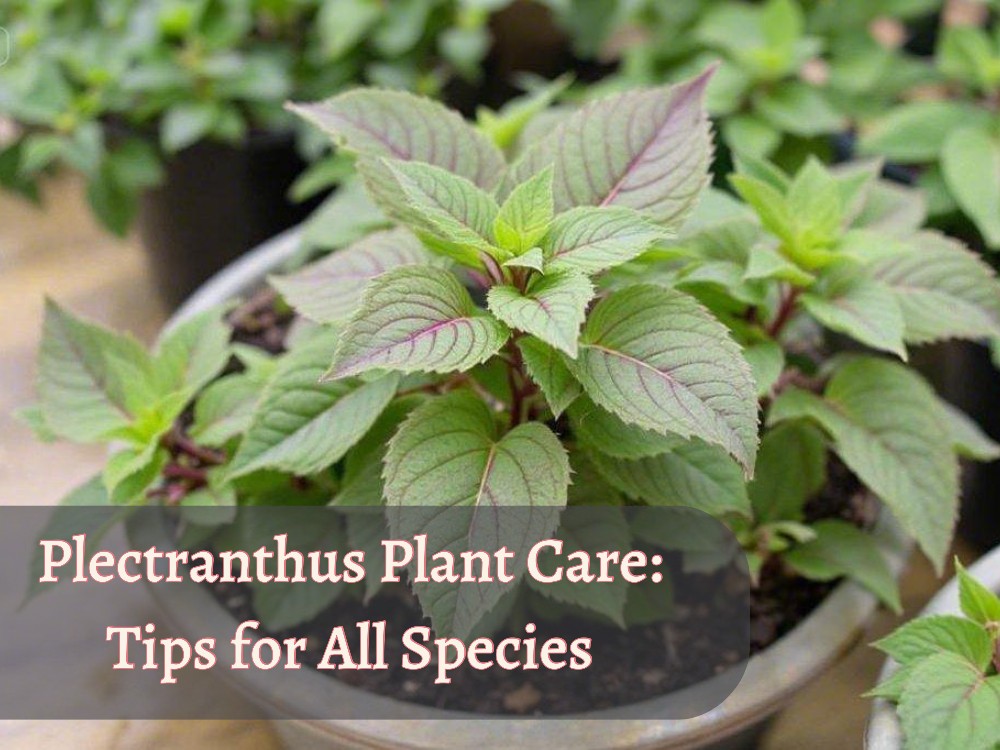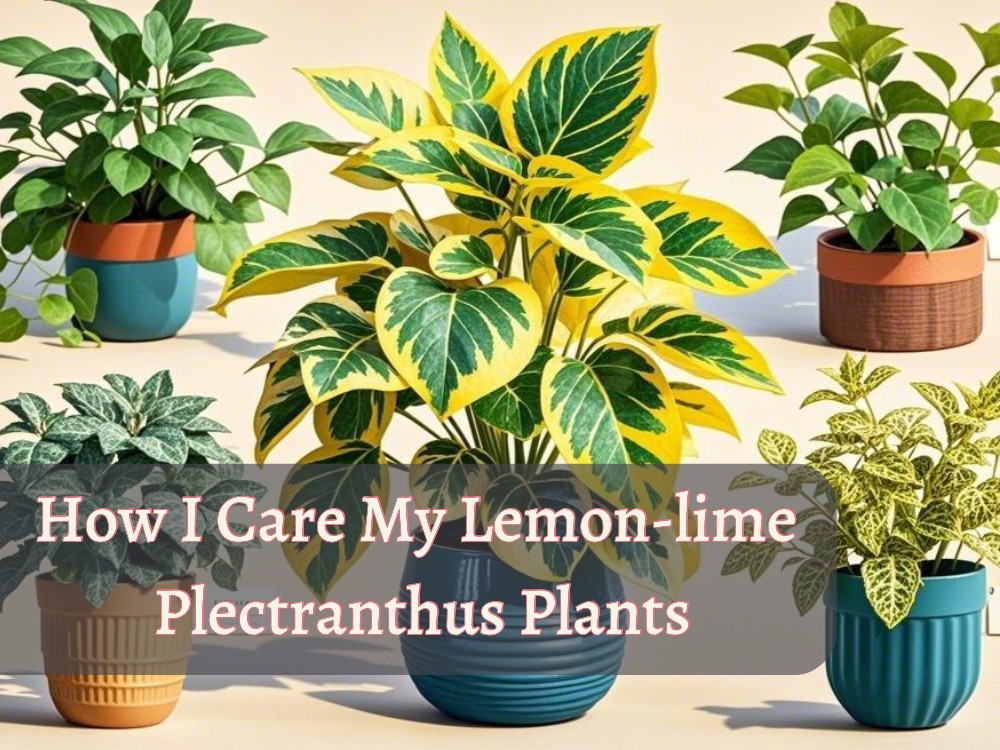Plectranthus Plant Care involves understanding the growing method for each species and the best techniques for propagation at home. It’s crucial to recognize essential requirements for the Plectranthus plant, such as soil, air, temperature, water, and pest control.
So, let’s start before understanding Plectranthus.
- What to Expect from This Plectranthus Growing and Caring Guide
- Choose the Best Propagation Method for Plectranthus
- Start with Healthy Plectranthus Plant Material
- Prepare the Perfect Growing Medium for Plectranthus
- Plant Plectranthus Cuttings, Division, Layering
- Provide Ideal Conditions for Plectranthus Growth
- Transplant Plectranthus to Pot or Ground
- Maintain Your Plectranthus Regularly
- Enjoy Your Fully Matured Plectranthus Plant
- FAQ's
What to Expect from This Plectranthus Growing and Caring Guide
Plectranthus is a genus with 85+ species having unique properties. I hope you have guessed the term “Plectranthus” is a broad classification that covers several distinct species. It seems like a general concept, Right?
In this guide, I will teach you a general method of growing and caring for Plectranthus that will work for all species.
Every species of Plectranthus has its requirements, so planting them according to their preferred climate type is ideal for better growth. Such as here is the unique care guide for Plectraanthus lemon lime!
For instance, if you want to know about growing or caring for specific species like Indian Borage (Plectranthus amboinicus) or Swedish Ivy (Plectranthus australis), you need to ensure you meet their unique soil, climate conditions, and light needs to help them thrive in your garden.
This guide offers only general caring and growing methods that benefit all Plectranthus species, which we will explore
- Providing well-draining soil.
- Maintaining consistent watering without overwatering.
- Ensuring adequate sunlight or partial shade depending on the species.
- Regular pruning to encourage healthy growth.
Here’s explore 10 reasons why your plants aren’t thriving in their environment.
Growing Process for Plectranthus: From Initial Stage to Final Growth
Let’s start this tutorial! You can jump out for any step that you want;
- Choose the Best Propagation Method for Plectranthus
- Start with Healthy Plectranthus Plant Material
- Prepare the Perfect Growing Medium for Plectranthus
- Plant Plectranthus Cuttings or Seeds
- Provide Ideal Conditions for Plectranthus Growth
- Transplant Plectranthus to Pot or Ground
- Maintain Your Plectranthus Regularly
- Enjoy Your Fully Matured Plectranthus Plant
Choose the Best Propagation Method for Plectranthus
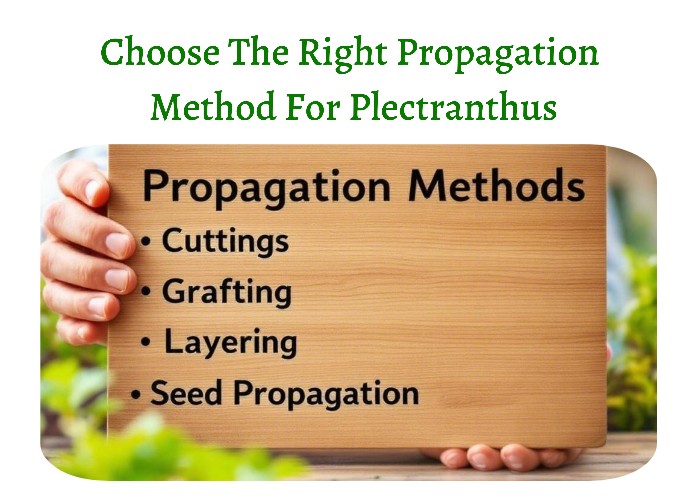
Understanding propagation methods is vital as different species of Plectranthus have varying growth needs.
Some species thrive through stem cuttings, while others may benefit more from layering or seed propagation.
Select the suited propagation method that directly interacts with the growth habits of your chosen piece of Plectranthus.
Here is the detailed source link for how environmental factors affect plant growth traits.
- Stem Cutting Propagation
- Layering Propagation
- Division Propagation
- For Trailing Species: Layering or Stem Cutting
- For Spreading Species: Division or Stem Cutting
- For Climbing Species: Layering or Stem Cutting
- For Upright Species: Only Stem Cutting
- For Bushy Species: Only Stem Cutting
Check which plant has the ability for cutting propagation! and explore all basic types of cutting propagation here!
Start with Healthy Plectranthus Plant Material

Planting Plectranthus with healthy, high-quality plant material. The idea behind this concept is you use the right material for plant propagation, depending on your selected propagation method.
For Stem Cutting
- For example, you require a non-flowering stem with healthy leaves for cuttings. Also, avoid any material having mold or any disease!
For Layering
- In the case of layering propagation, take a strong and flexible stem from the plant to establish roots gently in the soil.
For Division
- Always divide a mature and healthy plant for division propagation. The root ball should be an established one with many good roots attached to it.
Prepare the Perfect Growing Medium for Plectranthus

Growing medium also comes in materials required for propagation. Providing an ideal growing medium for Plectranthus species is crucial for optimal growth.
Soil Type
So, Plectranthus loves well-drainage soil that doesn’t hold water for too long. Loamy and slightly acidic soil can be best for Plectranthus.
However, if the soil is too dense or wet, you can mix in sand or perlite to improve drainage. Explore difference between moist and wet soil!
Compost or Well-rotted Manure
Mixing organic material improves nutrient-holding capacity, making soil healthy and fertile for Plectranthus species. So, integrate compost or well-rotted manure in the soil before starting.
For instance, if you want to mix your own growing medium, you can use the following formula;
- 1 part peat moss (to retain moisture)
- 1 part perlite (for drainage)
- 1 part compost or well-rotted manure (for nutrients)
Pots or Container
➔If planting Plectranthus in pots or containers, keep drainage holes at the bottom. Don’t have drainage holes in the pot or container?
Use an effective strategy: dig a few small holes or put a layer of small rocks or pebbles at the bottom of the pots, which will help the water drain.
Plant Plectranthus Cuttings, Division, Layering
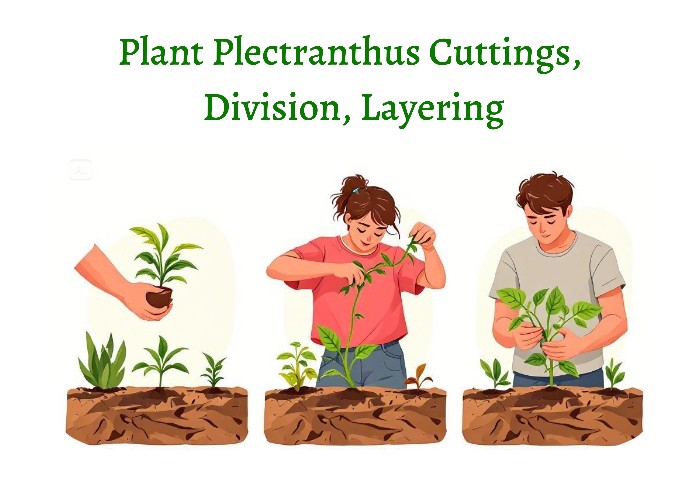
Now it’s time to plant plectranthus after understanding growth habits and preparing materials. Understand how growth habits affect propagation methods and propagate accordingly.
Use layering or stem cutting for trailing and climbing species of Plectranthus.
- Layering Propagation: Simple layering is ideal for trailing species, while air layering is the most effective for climbing species. You can also use simple layering for both!
- Stem Cutting: Softwood cutting is ideal for trailing species, and semi-hardwood cutting will be effective for climbing species. However, hardwood cutting can also work for both!
Use division or stem-cutting techniques for spreading species of Plectranthus.
- Division Propagation: Clump division is the best way to propagate spreading species of Plectranthus.
- Stem Cutting: If you choose a cutting method, semi-hardwood cutting is ideal for strong root development.
Consider only stem-cutting propagation for bushy and upright species of Plectranthus.
- Stem Cutting: Softwood cutting is most suitable for bushy species, and hardwood is ideal for upright species, but you can also use hardwood for both.
Provide Ideal Conditions for Plectranthus Growth
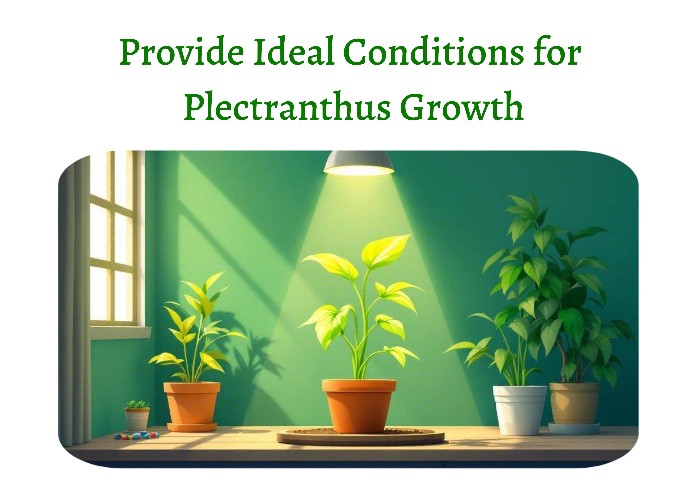
Temperature Conditions
Generally, Plectranthus prefers temperatures between 68 to 86F (15 to 29C). But in these three durations, I will recommend providing the following routine;
- During the Propagation of Plectranthus
Warm and stable temperature with a range of 22 to 25C (72 to 77F)
- For Root Development
A moderate temperature is ideal between 20 to 24C (68 to 75F)
- Final Growth of Plectranthus
Temperature of 20 to 30C (68 to 86F) is balanced but protects from extreme heat or cold.
Light Requirements
To give balanced light indoors, place the Plectranthus plant near a window where indirect sunlight can reach.
In the case of outdoor planting, keep the Plectranthus plant under a tree or in the corner where half a partial shade is available.
But if you live in cold zones, plant Plectranthus indoors and give its preferred condition. Just remember, Plectranthus can not grow under 10C and above 35C.
Humidity Level
Plectranthus prefers high humidity, which can not be available properly indoors, affecting plant growth. You can use a humidifier or pebble tray indoors to increase humidity levels.
However, Plectranthus can get natural and preferred conditions in tropical and subtropical areas.
Watering Needs
If the Plectranthus plant suffers from yellow leaves, this can be due to less watering.
Adjust the watering schedule and leave the water when the upper 2 to 3-inch layer of the soil is dry to prevent rotting. Check signs that your Plectranthus really needs water or not.
Transplant Plectranthus to Pot or Ground

Timing for Transplant Plectranthus
You may see healthy roots with your propagated plant;
- Stem Cutting Time: After 2 to 4 weeks
- Division Propagation: After 3 to 4 weeks
- Layering Propagation: After 4 to 6 weeks
So, wait until roots show up healthy and transplantable.
Choose The Right Spot
The Pot should be big and have proper drainage holes. For bushy or spreading species, take a pot with a diameter of 12-14 inches. Select a pot 14-16 inches deeper for climbing or upright species.
While transplanting in garden ground, choose a place with partial shade for climbing species such as Plectranthus australis as it prefers.
Transplant bushy or spreading (Plectranthus amboinicus) species in full sunlight.
Soil Preparation
- Mix compost or perlite in pre-mixed potting soil for pot.
- Loose ground soil by using a spade and mix organic compost.
- Always keep the soil slightly moist during transplanting Plectranthus.
Root Ball Care
When you transplant a cutting or seedling into a pot or garden bed, handle the roots gently to avoid damaging them. If roots are tangled, you can trim them a little.
How to Transplant?
Make a hole of appropriate depth in the pot or garden soil, place the plant in the hole, and gently fill and press the soil in, but do not compress the roots. Ensure the root ball is buried in the soil to drain water effectively.
Maintain Your Plectranthus Regularly
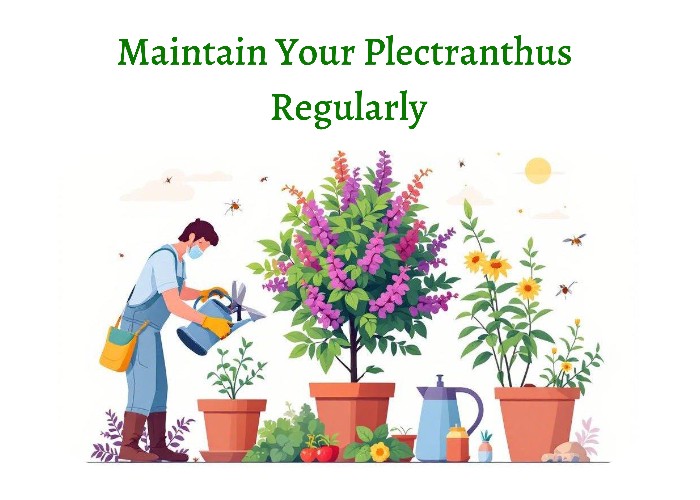
Regular maintenance is also crucial for Plectranthus species to grow healthy. Here are some more must-follow tips for Plectranthus species;
Watering
Plectranthus requires consistent watering, especially in tropical and subtropical areas where temperature can become too intense and the soil dries quickly.
Watering becomes crucial when the upper layer of soil is about 2 to 3 inches dry out.
Explore 4 clear signs that your plant need water!
Pruning
Plectranthus species are most attractive in shape, and to encourage their growth and structure, regular pruning is the most essential step in Plectranthus’ care routine.
However, when leaves turn yellow, this is a sign of less watering, but if it is too damaged, remove them.
Fertilizing
Plectranthus needs light feeding, especially in the growing season (Spring to Summer). Use a liquid fertilizer, which supplies steady nutrients to plants.
If the soil is too acidic, use calcium carbonate fertilizer to balance soil acidity as Plectranthus species want (slightly acidic). Reduce fertilizing when winter comes.
Pests Control
Due to its attractive and aromatic properties, some common pests, such as aphids or bugs, attack your Plectranthus plant. Regularly inspect leaves and use natural insecticides or soapy water to remove them.
Your one-step forward regular pet inspection can handle pest problems at an early stage.
Repotting
If your Plectranthus are growing in a pot, regular repotting is vital. If the roots are growing out of the pot or the plant’s growth has slowed, shift the plant to a larger pot.
Enjoy Your Fully Matured Plectranthus Plant
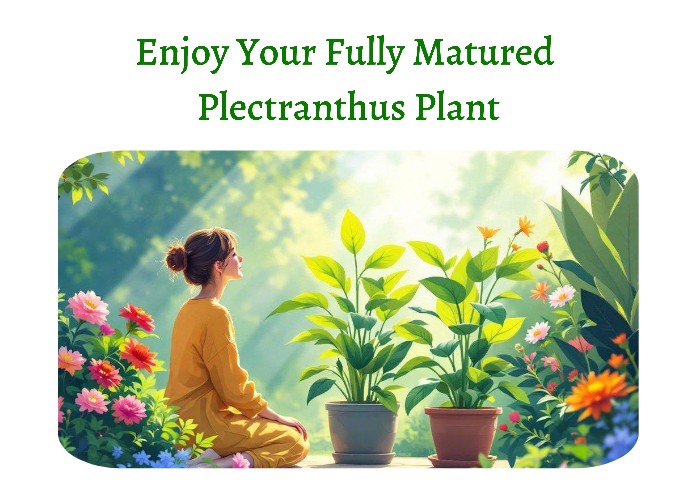
You have taken good care of your Plectranthus plant, and now it is time to enjoy the beauty and growth of a fully mature plant.
When your Plectranthus is healthy and strong, its presence gives a fresh and vibrant look.
Here are some tips that will help you enjoy your mature Plectranthus plant to the fullest:
Appreciate its beauty
Mature Plectranthus are known for their beautiful foliage and flowers.
Plectranthus australis is a trailing species perfect for hanging baskets, and Plectranthus amboinicus is a dwarf species perfect for garden beds. You can grow your plant and enjoy its unique color and leaf patterns.
Use it in your garden design.
Your fully mature Plectranthus plant can be strategically used in garden design to give your garden a new lease of life.
These trailing or bushy species can be used as border plants, ground covers, and container plants.
Harvesting Leaves
You can harvest the leaves if you have a Plectranthus amboinicus or similar medicinal species.
You can use the leaves for cooking, tea, or medicinal purposes. It will also give your plant additional value.
Keep an eye on the flowers.
The mature plant will begin to bloom. Plectranthus’ flowers are beautiful. Continue to care for your plant until it blooms to its full potential.
Continue to prune for a better shape.
By pruning regularly, you can keep your mature Plectranthus healthy and aesthetically pleasing. Pruning makes the plant bushier and encourages new shoots to develop, making the plant more attractive.
Enjoy its scent
Some species of Plectranthus, such as Indian borage, have a natural scent. You can enjoy the fragrance indoors, giving your living space a natural, fresh feel.
Final Thoughts: Plectranthus Plant Care Guide
Plectranthus plant care is easy, but make sure you are familiar with a caring guide for chosen species that can be unique to this general guide.
If you want to plant a specific piece of PLectranthus, comment or message me. I will share my knowledge and thoughts in a detailed tutorial.
Thanks for reading! I hope you will enjoy its harvest in different interesting ways.
